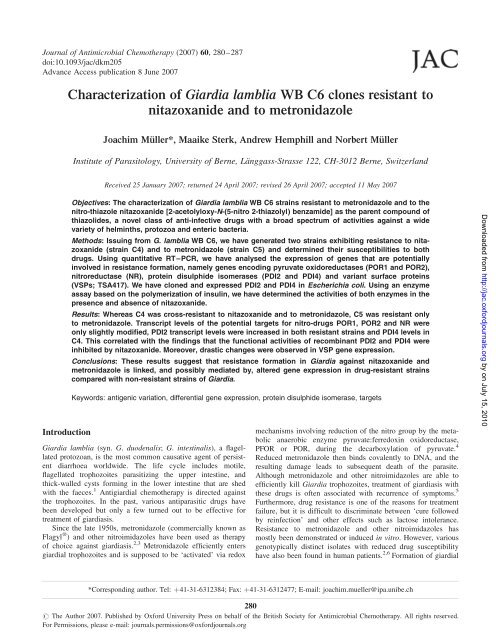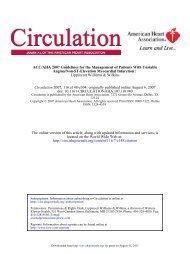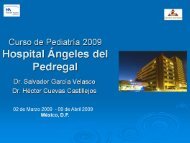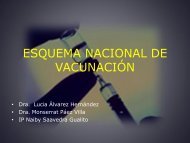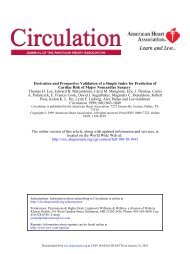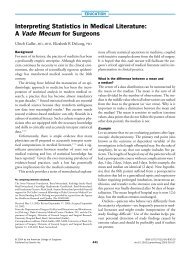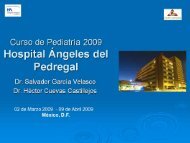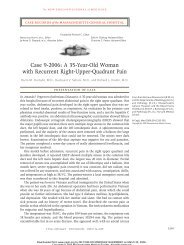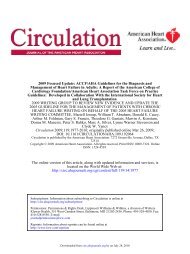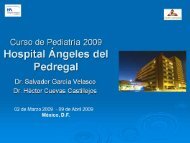Characterization of Giardia lamblia WB C6 clones resistant to ...
Characterization of Giardia lamblia WB C6 clones resistant to ...
Characterization of Giardia lamblia WB C6 clones resistant to ...
- No tags were found...
You also want an ePaper? Increase the reach of your titles
YUMPU automatically turns print PDFs into web optimized ePapers that Google loves.
Journal <strong>of</strong> Antimicrobial Chemotherapy (2007) 60, 280–287doi:10.1093/jac/dkm205Advance Access publication 8 June 2007<strong>Characterization</strong> <strong>of</strong> <strong>Giardia</strong> <strong>lamblia</strong> <strong>WB</strong> <strong>C6</strong> <strong>clones</strong> <strong>resistant</strong> <strong>to</strong>nitazoxanide and <strong>to</strong> metronidazoleJoachim Müller*, Maaike Sterk, Andrew Hemphill and Norbert MüllerInstitute <strong>of</strong> Parasi<strong>to</strong>logy, University <strong>of</strong> Berne, Länggass-Strasse 122, CH-3012 Berne, SwitzerlandReceived 25 January 2007; returned 24 April 2007; revised 26 April 2007; accepted 11 May 2007IntroductionObjectives: The characterization <strong>of</strong> <strong>Giardia</strong> <strong>lamblia</strong> <strong>WB</strong> <strong>C6</strong> strains <strong>resistant</strong> <strong>to</strong> metronidazole and <strong>to</strong> thenitro-thiazole nitazoxanide [2-ace<strong>to</strong>lyloxy-N-(5-nitro 2-thiazolyl) benzamide] as the parent compound <strong>of</strong>thiazolides, a novel class <strong>of</strong> anti-infective drugs with a broad spectrum <strong>of</strong> activities against a widevariety <strong>of</strong> helminths, pro<strong>to</strong>zoa and enteric bacteria.Methods: Issuing from G. <strong>lamblia</strong> <strong>WB</strong> <strong>C6</strong>, we have generated two strains exhibiting resistance <strong>to</strong> nitazoxanide(strain C4) and <strong>to</strong> metronidazole (strain C5) and determined their susceptibilities <strong>to</strong> bothdrugs. Using quantitative RT–PCR, we have analysed the expression <strong>of</strong> genes that are potentiallyinvolved in resistance formation, namely genes encoding pyruvate oxidoreductases (POR1 and POR2),nitroreductase (NR), protein disulphide isomerases (PDI2 and PDI4) and variant surface proteins(VSPs; TSA417). We have cloned and expressed PDI2 and PDI4 in Escherichia coli. Using an enzymeassay based on the polymerization <strong>of</strong> insulin, we have determined the activities <strong>of</strong> both enzymes in thepresence and absence <strong>of</strong> nitazoxanide.Results: Whereas C4 was cross-<strong>resistant</strong> <strong>to</strong> nitazoxanide and <strong>to</strong> metronidazole, C5 was <strong>resistant</strong> only<strong>to</strong> metronidazole. Transcript levels <strong>of</strong> the potential targets for nitro-drugs POR1, POR2 and NR wereonly slightly modified, PDI2 transcript levels were increased in both <strong>resistant</strong> strains and PDI4 levels inC4. This correlated with the findings that the functional activities <strong>of</strong> recombinant PDI2 and PDI4 wereinhibited by nitazoxanide. Moreover, drastic changes were observed in VSP gene expression.Conclusions: These results suggest that resistance formation in <strong>Giardia</strong> against nitazoxanide andmetronidazole is linked, and possibly mediated by, altered gene expression in drug-<strong>resistant</strong> strainscompared with non-<strong>resistant</strong> strains <strong>of</strong> <strong>Giardia</strong>.Keywords: antigenic variation, differential gene expression, protein disulphide isomerase, targets<strong>Giardia</strong> <strong>lamblia</strong> (syn. G. duodenalis; G. intestinalis), a flagellatedpro<strong>to</strong>zoan, is the most common causative agent <strong>of</strong> persistentdiarrhoea worldwide. The life cycle includes motile,flagellated trophozoites parasitizing the upper intestine, andthick-walled cysts forming in the lower intestine that are shedwith the faeces. 1 Antigiardial chemotherapy is directed againstthe trophozoites. In the past, various antiparasitic drugs havebeen developed but only a few turned out <strong>to</strong> be effective fortreatment <strong>of</strong> giardiasis.Since the late 1950s, metronidazole (commercially known asFlagyl w ) and other nitroimidazoles have been used as therapy<strong>of</strong> choice against giardiasis. 2,3 Metronidazole efficiently entersgiardial trophozoites and is supposed <strong>to</strong> be ‘activated’ via redoxmechanisms involving reduction <strong>of</strong> the nitro group by the metabolicanaerobic enzyme pyruvate:ferredoxin oxidoreductase,PFOR or POR, during the decarboxylation <strong>of</strong> pyruvate. 4Reduced metronidazole then binds covalently <strong>to</strong> DNA, and theresulting damage leads <strong>to</strong> subsequent death <strong>of</strong> the parasite.Although metronidazole and other nitroimidazoles are able <strong>to</strong>efficiently kill <strong>Giardia</strong> trophozoites, treatment <strong>of</strong> giardiasis withthese drugs is <strong>of</strong>ten associated with recurrence <strong>of</strong> symp<strong>to</strong>ms. 5Furthermore, drug resistance is one <strong>of</strong> the reasons for treatmentfailure, but it is difficult <strong>to</strong> discriminate between ‘cure followedby reinfection’ and other effects such as lac<strong>to</strong>se in<strong>to</strong>lerance.Resistance <strong>to</strong> metronidazole and other nitroimidazoles hasmostly been demonstrated or induced in vitro. However, variousgenotypically distinct isolates with reduced drug susceptibilityhave also been found in human patients. 2,6 Formation <strong>of</strong> giardialDownloaded from http://jac.oxfordjournals.org by on July 15, 2010.....................................................................................................................................................................................................................................................................................................................................................................................................................................*Corresponding author. Tel: þ41-31-6312384; Fax: þ41-31-6312477; E-mail: joachim.mueller@ipa.unibe.ch.....................................................................................................................................................................................................................................................................................................................................................................................................................................280# The Author 2007. Published by Oxford University Press on behalf <strong>of</strong> the British Society for Antimicrobial Chemotherapy. All rights reserved.For Permissions, please e-mail: journals.permissions@oxfordjournals.org
Müller et al.Table 1. Schedule for the establishment <strong>of</strong> nitazoxanide (NTZ)-and metronidazole (MET)-<strong>resistant</strong> G. <strong>lamblia</strong> <strong>WB</strong> <strong>C6</strong> lines prior <strong>to</strong>cloning (at the indicated time points, trophozoite medium wasreplaced with new medium containing NTZ or MET as indicated)Time (days) NTZ (mM) MET (mM)0 5 103 7.5 155 7.5 1510 10 2012 10 2014 10 2017 15 3019 0 3021 10 4024 15 4027 20 5030 20 5034 25 6037 25 6041 transformation in<strong>to</strong> stabilates, s<strong>to</strong>ragein liquid nitrogenRecovery0 0 01 20 506 25 5010 25 5014 40 60cell lines were generated by two rounds <strong>of</strong> dilution <strong>of</strong> trophozoitesin drug-free medium and transfer <strong>to</strong> 96-well plates with an expectancevalue (l) <strong>of</strong> 0.5 trophozoites per well according <strong>to</strong> thePoisson law P l (n) ¼ l n /n! e 2l , n being the number <strong>of</strong> events andP l (n) being the probability for n <strong>to</strong> occur with an expectance valuel. The plates were incubated in an anaerobic incuba<strong>to</strong>r (ScholzenMicrobiology Systems, Kriems, Switzerland) containing 100% N 2for 2 days. Wells were then screened for growing trophozoites andthe contents <strong>of</strong> 10 wells with growing trophozoites for each drugresistance were then transferred <strong>to</strong> normal culture tubes containingdrug-free medium and allowed <strong>to</strong> recover for 1 day. Then, drugswere added (40 mM nitazoxanide and 60 mM metronidazole,respectively). The <strong>clones</strong> having maintained their resistance (four inthe case <strong>of</strong> nitazoxanide and six in the case <strong>of</strong> metronidazole) weresubcultivated. The <strong>clones</strong> with the best growth, i.e. thenitazoxanide-<strong>resistant</strong> clone C4 and the metronidazole-<strong>resistant</strong>clone C5, were selected for detailed characterization.Processing <strong>of</strong> RNA samples and quantitative RT–PCRTo quantify gene expression by real-time RT–PCR, trophozoites <strong>of</strong><strong>WB</strong> <strong>C6</strong> wild-type, <strong>clones</strong> C4 and C5 were grown in the absence <strong>of</strong>drugs until near confluence was reached. Cells were harvested asdescribed and RNA was extracted using the Qiagen RNeasy TM kitand including a DNase I digestion (<strong>to</strong> remove residual genomicDNA) according <strong>to</strong> the manufacturer’s instructions. RNA was elutedwith 50 mL RNase-free water and s<strong>to</strong>red at 2808C.First strand cDNA was synthesized using the QiagenOmniscript TM RT kit as described by the manufacturer with randomprimers for subsequent ACT-, CWP1-, GDH-, NR-, PDI2-,PDI4,- POR1-, POR4- and 16S rRNA-PCR or with a polyT-ANCprimer 24 for subsequent VSP <strong>to</strong>t -, TSA417- and ACT-PCR (forprimer sequences, see Table 2). Overall amplifications <strong>of</strong> cDNAmolecules representing analogues <strong>of</strong> mRNA from different VSPgenes (VSP <strong>to</strong>t ) were performed by 3 0 RACE PCR as previouslydescribed. 24 Briefly, amplification reaction mixes included a forwardprimer (primer VSP <strong>to</strong>t ) complementary <strong>to</strong> a highly conserved VSPgene region (MM16 region, as described previously; 25 see Table 2)and a reverse anchor (ANC) primer (Table 2). 24 Quantitative PCRwas done with 4 mL <strong>of</strong> 1:100-diluted cDNA using the QuantiTect TM SYBR Green PCR Kit (Qiagen) in a 10 mL standard reactioncontaining a 0.5 mM concentration <strong>of</strong> forward and reverse primers(MWG Biotech, Ebersberg, Germany). Furthermore, a control PCRincluded RNA equivalents from samples that had not been reversetranscribed in<strong>to</strong> cDNA (data not shown) <strong>to</strong> confirm that no DNAwas amplified from any residual genomic DNA that might haveresisted DNase I digestion (see above). PCR was started by initiatingthe ‘Hot-Start’ Taq DNA polymerase reaction at 958C (15 min).Subsequent DNA amplification was done in 40 cycles includingdenaturation (948C, 15 s), annealing (608C, 30 s) and extension(728C, 30 s); temperature transition rates in all cycle steps were208C/s. Fluorescence was measured at 828C with primers for ACT-,CWP1-, GDH-, NR-, PDI2-, PDI4,- POR1-, POR2- and 16SrRNA-PCR or 798C for VSP<strong>to</strong>t-and TSA417-PCR during the temperatureshift after each annealing phase. From the quantitative RT–PCR, mean values (+SE) from triplicate determinations wereassessed and expression levels <strong>of</strong> the genes summarized in Table 2were given as values in arbitrary units relative <strong>to</strong> the amount <strong>of</strong> 16SrRNA (for mRNA representing ACT, CWP1, GDH, NR, PDI2,PDI4, POR1 and POR2) or the constitutively expressed ‘housekeeping’ gene ACT (for mRNA representing VSP <strong>to</strong>t and TSA417).Cloning and heterologous expression <strong>of</strong>G. <strong>lamblia</strong> PDI2 and PDI4In order <strong>to</strong> clone GlPDI2 and GlPDI4 in<strong>to</strong> the His-tag-expressionvec<strong>to</strong>r pET151 directional TOPO (Invitrogen, Carlsbad, Canada),primers were created for the amplification <strong>of</strong> gene fragments encodingthe PDI polypeptides without signal peptides (Table 2). CACCat the 5 0 end was added in order <strong>to</strong> allow directional cloning (MWGBiotech, Ebersberg, Germany).For amplification by PCR, DNA was extracted from 10 6 trophozoitesusing the DNeasy TM kit (Qiagen, Hilden, Germany) according<strong>to</strong> the manufacturer’s instructions and eluted from the spincolumn with 50 mL ultrapure water. The PCR was performed using0.6 U <strong>of</strong> Pfu (Promega, Madison, WI, USA), 2 mL <strong>of</strong>Pfu buffer10 (Promega), 20 pmol <strong>of</strong> each primer, 0.16 mM dNTPs(Promega) and 0.1–1 mL <strong>of</strong> DNA diluted 1/10 in a <strong>to</strong>tal volume <strong>of</strong>20 mL. The amplification was performed at 568C (PDI2) or 548C(PDI4) annealing temperature during 28 cycles in a GeneAmp TMPCR System 9700 thermocycler (Applied Biosystems, Foster City,CA, USA). The resulting products were inserted in<strong>to</strong> pET151 usingthe respective cloning kit according <strong>to</strong> the manufacturer’s instructions.The vec<strong>to</strong>r was transformed in<strong>to</strong> Escherichia coli TOP 10cells (Invitrogen).For heterologous expression <strong>of</strong> recombinant PDIs, miniprepDNA from E. coli TOP 10 containing the plasmid with the insert incorrect orientation was batch transformed in<strong>to</strong> E. coli BL21 Star(Invitrogen). The batch was grown overnight in 2 mL <strong>of</strong> LB with100 ppm carbenicillin, then transferred <strong>to</strong> a 500 mL Erlenmeyercontaining 50 mL <strong>of</strong> LB with 100 ppm carbenicillin and grown untilA 600 0.5 was reached. Expression <strong>of</strong> recombinant PDIs was inducedby addition <strong>of</strong> 1 mM IPTG. As a negative control, 10 mL <strong>of</strong> cultureDownloaded from http://jac.oxfordjournals.org by on July 15, 2010282
Table 2. Overview <strong>of</strong> primers used in this studyNitazoxanide resistance in <strong>Giardia</strong> <strong>lamblia</strong>GeneAccession numberRegion <strong>of</strong> CDS orrRNA Primer (5 0 ! 3 0 )Actin (ACT)EAA39190Cyst wall protein 1 (CWP1)XM 766142.1Glutamate dehydrogenase (GDH)XM_773614Nitroreductase (NR)EAA43030.1Protein disulphide isomerase 2 (PDI2)EAA42483.1Protein disulphide isomerase 4 (PDI4)AF295634.1CDS 715–933CDS 367–713CDS 761–893CDS 526–794 plus 8 <strong>of</strong> 3 0 utr.CDS 1055–1350 plus 13 <strong>of</strong> 3 0 utr.CDS 57–1350 plus 12 <strong>of</strong> 3 0 utr.CDS 46–1065CDS 775–1065 plus 1 <strong>of</strong> 3 0 utr.was withdrawn prior <strong>to</strong> induction and cultivated in a 100 mLErlenmeyer. Cells were harvested after 3.5 h, chilled down, pelletedby centrifugation (4000 g, 20 min, 48C) and s<strong>to</strong>red at –208C.For His-tag purification, pellets from induced E. coli cells weresuspended in 0.5 mL <strong>of</strong> 1 LEW buffer (Macherey-Nagel, Düren,Germany) containing 0.5% Tri<strong>to</strong>n X-100 and 10 mL <strong>of</strong> proteaseinhibi<strong>to</strong>r cocktail suitable for His-tag purification (Sigma P8849).The suspension was freeze-thawed three times on dry ice, then centrifugedfor 15 min at 13 000 g and 48C. The extraction wasrepeated once. Supernatants were combined and loaded on ProtinoNi-TED 150 columns (Macherey-Nagel) in tandem. Columns werewashed with 1 LEW buffer, proteins were eluted with elutionbuffer according <strong>to</strong> the manufacturer’s instructions. Eluted proteinwas s<strong>to</strong>red in 50% glycerol at 2208C.PDI enzyme assayPDI activity was measured by a turbidimetric assay based on thepolymerization <strong>of</strong> reduced insulin. 18,26,27 The assay was performedin 96-well microtitre plates (Nunc). Per well, 80 mL <strong>of</strong> assay buffer(potassium phosphate 100 mM, pH 7.0) was mixed with 10 mL <strong>of</strong>bovine pancreas insulin (1.6 mM, dissolved in 0.1 M HCl) andenzymes (0–5 mL) or buffer (substrate blank). The reaction wasstarted by addition <strong>of</strong> 5 mL <strong>of</strong> dithiothrei<strong>to</strong>l (20 mM in assaybuffer). After 2 min <strong>of</strong> preincubation, absorbance at 630 nm wasread at various time points (0–20 min) on a 96-well plate reader(MRXII, Dynex, Chantilly, VA, USA). Enzyme activity was calculatedfrom the linear increase in turbidity over time.ResultsACTquantF ACATATGAGCTGCCAGATGGACTquantR TCGGGGAGGCCTGCAAACCWP1quantF GGCGATATTCCCGAGTGCATGTGCWP1quantR GTGAGGCAGTACTCTCCGCAGTGDHquantF AGGTCCTCACCTTCTCAGACTGDHquantR GGATACTTGTCCTTGAACTCGGNRquantF CCTGCTGACAAGGCCGCANRquantR AACACCAATTACTTAAATGTAATGPDI2quantF GGCCCAGGGCGAGGAGTPDI2quantR AGACAAGAACCGTTTACTTCTTPDI2fullF CACCTTGGTTCTCACGCAAGACAPDI2fullR GACAAGAACCGTTTACTTCTPDI4fullF CACCGAGGTGCTCGTTCTCCAPDI4fullR TCAGAGCTCCTTGTCCCCPDI4quantF CCGAAGGACGAGACTTCCTPDI4quantR CTCAGAGCTCCTTGTCCCCPOR1quantF ATCCAACGCGACCCAGAAGPOR1quantR GTTCACTGCTTACTCCGCCPOR2quantF CTCGCACATGGTCCAGGGPOR2quantR AGAGCCGCAGCCATCTCCGl16SquantF GACGGCTCAGGACAACGGGl16SquantR CTCTCCGGAGTCGAACCCTSA417quantF TGTGGAACGTGTGCCAATAGTSA417quantR AGACACGTAGTACAGTCGGPyruvate oxidoreductase 1 (POR1) CDS 3341–3600 plus 9 <strong>of</strong> 3 0 utr.<strong>Giardia</strong> DB orf:17063Pyruvate oxidoreductase 2 (POR2) CDS 3325–3547<strong>Giardia</strong> DB orf:114609Ribosomal RNA 16S (16S rRNA) CDS 79–300M54878.1Variant surface protein TSA417 CDS 127–335U89152.1Variant surface protein (<strong>to</strong>tal) see Von Allmen et al. 24 VSP <strong>to</strong>t quantF (MM16) GGCTTCCTCTGCTGGTGGTTCVSP <strong>to</strong>t quantR (ANC) GACCACGCGTATCGATGTCGACDS, coding sequence; utr., untranslated.Generation <strong>of</strong> nitazoxanide- and metronidazole-<strong>resistant</strong>G. <strong>lamblia</strong> trophozoitesBy axenic culture <strong>of</strong> G. <strong>lamblia</strong> <strong>WB</strong> <strong>C6</strong> trophozoites in the presence<strong>of</strong> slowly and continuously increasing concentrations <strong>of</strong>nitazoxanide and metronidazole, respectively (Table 1), twodrug-<strong>resistant</strong> trophozoite lines were generated, transformed in<strong>to</strong>stabilates, s<strong>to</strong>red in liquid nitrogen and subsequently recoveredin trophozoite medium. These trophozoite lines were subculturedin the presence <strong>of</strong> up <strong>to</strong> 40 mM nitazoxanide and 60 mM metronidazole,respectively. Clones from <strong>resistant</strong> cell lines were generatedand growth <strong>of</strong> the nitazoxanide-<strong>resistant</strong> clone C4 and themetronidazole-<strong>resistant</strong> clone C5 was tested on normal medium.All three <strong>clones</strong> reached comparable densities at 4 days afterinoculation, C5 started however, with a delay (Figure 1). Uponprolonged growth in drug-free medium for more than 10 generations,resistance was maintained. The <strong>clones</strong> C4 and C5encysted as well as the wild-type when put on encystationmedium (data not shown).Downloaded from http://jac.oxfordjournals.org by on July 15, 2010283
magnitude lower than the POR genes and the ACT gene. In the<strong>clones</strong> C4 and C5, NR expression levels were only slightlydecreased (69% <strong>of</strong> wild-type level in C4 and 78% <strong>of</strong> wild-typelevel in C5; Figure 3).In addition, we analysed expression levels <strong>of</strong> PDI2 and PDI4,two major PDIs in <strong>Giardia</strong>. The expression level <strong>of</strong> PDI2 wasapproximately three magnitudes lower than the actin expressionlevel. PDI2 gene expression was significantly increased in both<strong>resistant</strong> <strong>clones</strong> (230% <strong>of</strong> wild-type level in clone C4 and 255%in clone C5) PDI4 exhibited two magnitudes higher geneexpression levels as compared with PDI2. In thenitazoxanide-<strong>resistant</strong> clone C4, PDI4 gene expression wasincreased <strong>to</strong> nearly twice the wild-type levels, whereas in themetronidazole-<strong>resistant</strong> clone C5, PDI4 gene expression levelsremained nearly unchanged (Figure 3).Nitazoxanide resistance in <strong>Giardia</strong> <strong>lamblia</strong>Recombinant PDI is inhibited by nitazoxanideWhen subjected <strong>to</strong> a PDI enzyme assay based on the polymerization<strong>of</strong> reduced insulin, bacterially expressed and purifiedrecPDI4 was shown <strong>to</strong> be functionally active and catalysed thecross-linking <strong>of</strong> insulin monomers. Classical PDI inhibi<strong>to</strong>rs likebacitracin 30 and para-chloro-mercuri benzoic acid (PCMBA)readily inhibited the activity <strong>of</strong> the recPDI4. Interestingly, alsonitazoxanide and tizoxanide, but not metronidazole, inhibitedrecPDI4 activity (Figure 4). Similar results were obtained withusing recPDI2 where 50 mM nitazoxanide and tizoxanide showedinhibition <strong>to</strong> ,20% <strong>of</strong> the control levels (data not shown).VSP gene expression is strongly affected in nitazoxanideandmetronidazole-<strong>resistant</strong> G. <strong>lamblia</strong> <strong>clones</strong>The most dramatic differences between wild-type and <strong>resistant</strong>G. <strong>lamblia</strong> <strong>clones</strong> were found when expression <strong>of</strong> VSP geneswas investigated. For respective analyses, cDNA was synthesizedissuing from polyT-ANC primers instead <strong>of</strong> random oligoprimers (see the Materials and methods section). ThisFigure 5. Quantification <strong>of</strong> variant surface protein (VSP) gene expressionby real-time RT–PCR. Trophozoites were grown in normal culture mediumuntil near confluence was reached. RNA was extracted and reversetranscribed <strong>to</strong> cDNA. Transcripts <strong>of</strong> the VSP gene encoding TSA417 and<strong>to</strong>tal VSPs (VSP <strong>to</strong>t ) were quantified in relation <strong>to</strong> actin cDNA. Amounts areexpressed in arbitrary units (AU). Mean values (+SE) for triplicatedeterminations are given. wt, wild-type; NTZr, nitazoxanide-<strong>resistant</strong>;METr, metronidazole-<strong>resistant</strong>.experimental strategy allowed RT–PCRs <strong>to</strong> be performed with ageneral forward primer (MM16 primer) targeted <strong>to</strong> a highly conservedVSP gene region and a reverse primer targeted <strong>to</strong> the 3 0terminal ANC sequence adjacent <strong>to</strong> the polyT stretch <strong>of</strong> thecDNA molecules (Figure 5). By comparative quantitative RT–PCR, the cDNA synthesized with polyT-ANC was also amplifiedby including a primer pair specific for the gene TSA417that encodes the major VSP in <strong>WB</strong> <strong>C6</strong> (Figure 5). Values fromboth PCRs were determined relative <strong>to</strong> the ACT geneexpression, which was shown <strong>to</strong> be constant in wild-type and<strong>resistant</strong> strains (Figure 3). While wild-type clone <strong>WB</strong> <strong>C6</strong> exhibitedTSA417 gene expression, corresponding expression levelswere dramatically reduced and virtually non-detectable in <strong>resistant</strong><strong>clones</strong> C4 and C5. Conversely, the overall expression <strong>of</strong>VSP genes (VSP <strong>to</strong>t ) remained constant, suggesting that resistancewas associated with an antigenic switch from TSA417 <strong>to</strong> one, orseveral unknown VSPs (Figure 5).Downloaded from http://jac.oxfordjournals.org by on July 15, 2010Figure 4. PDI activity assay based on the reduction and polymerization <strong>of</strong>insulin with recombinant PDI4. Inhibition test with known PDI inhibi<strong>to</strong>rs,namely bacitracin (BAC; 3 mM) and para-chloro-mercuri benzoic acid(PCMBA; 0.1 mM), metronidazole (MET; 50 mM), nitazoxanide (NTZ;50 mM) and tizoxanide (TIZ; 50 and 100 mM). Assays were run in triplicate.Bars correspond <strong>to</strong> mean values (+SE).DiscussionOur present investigations have demonstrated that giardial resistance<strong>to</strong> nitazoxanide can be triggered in vitro, and that nitazoxanideresistance formation resulted in a simultaneous increase <strong>of</strong>resistance <strong>to</strong> metronidazole. Conversely, in vitro generatedmetronidazole resistance turned out <strong>to</strong> mediate no ‘crossresistance’<strong>to</strong> nitazoxanide. In particular, we have been successfulin generating in vitro the nitazoxanide-<strong>resistant</strong> clone C4 andthe metronidazole-<strong>resistant</strong> clone C5 <strong>of</strong> G. <strong>lamblia</strong> <strong>WB</strong> <strong>C6</strong>. Thetwo <strong>clones</strong> do not exhibit the same resistance pattern since C4 iscross-<strong>resistant</strong> <strong>to</strong> metronidazole, whereas C5 is sensitive <strong>to</strong> nitazoxanide.This latter finding is in agreement with observationsin Helicobacter pylori where nitazoxanide-<strong>resistant</strong> strains did285
Müller et al.not exhibit cross-resistance <strong>to</strong> metronidazole. 23 To our knowledge,clinically relevant resistance <strong>to</strong> nitazoxanide has neverbeen reported <strong>to</strong> date, either in H. pylori, 31 <strong>Giardia</strong> or inCryp<strong>to</strong>sporidium, 8,12 while metronidazole-<strong>resistant</strong> isolates <strong>of</strong>H. pylori and G. <strong>lamblia</strong> have been obtained from infectedpatients. 31Although nitazoxanide and metronidazole exhibit structuralsimilarities, the two compounds differentially affect <strong>Giardia</strong> interms <strong>of</strong> morphological alterations. 13 In addition, the differencesin respective resistance patterns as outlined above suggest differencesin their mode <strong>of</strong> action. Earlier findings had demonstratedthat reduction <strong>of</strong> the nitro group is crucial for metronidazoleactivation, 7 since oxidoreductases such as POR or other NRsthat are present in anaerobic or microaerophilic microorganismswill convert the nitro group in<strong>to</strong> a <strong>to</strong>xic radical. In addition, inthese organisms, resistance <strong>to</strong> metronidazole was associated withthe functional inhibition <strong>of</strong> POR activity. 3,4,32,33While it has been recently shown that nitazoxanide and tizoxanideboth inhibit the POR activities in <strong>Giardia</strong>, Trichomonas,Entamoeba and several anaerobic bacteria, 16 there is no evidencethat the thiazole-associated nitro group is actually reducedupon treatment <strong>of</strong> these organisms. In fact, this study suggeststhat unreduced nitazoxanide inhibits POR activity by interferingwith its c<strong>of</strong>ac<strong>to</strong>r thiamine pyrophosphate. 16 In any case, the presence<strong>of</strong> the nitro group was also found <strong>to</strong> be crucial for theantigiardial activity <strong>of</strong> several nitro-thiazolides with low inhibi<strong>to</strong>ryconstants. 13Taking these findings in<strong>to</strong> account, we decided <strong>to</strong> perform anRT–PCR-based investigation <strong>to</strong> assess the POR gene expressionlevels in the <strong>resistant</strong> <strong>clones</strong> C4 and C5. Here, thenitazoxanide-<strong>resistant</strong> clone C4 did not exhibit significantreduction <strong>of</strong> expression <strong>of</strong> the two POR genes, POR1 andPOR2, but clearly expression levels were reduced in themetronidazole-<strong>resistant</strong> clone C5 (Figure 3). This indicates thatmetronidazole resistance formation may occur in at least twodifferent manners including either reduction <strong>of</strong> POR geneexpression or an as yet unknown pathway that does not dependon an alteration <strong>of</strong> the respective enzymatic activity.Additional investigations on the expression <strong>of</strong> NR, anotherenzyme potentially involved in nitro reduction (Figure 3), showthat both giardial nitazoxanide and metronidazole resistance formationdo not lead <strong>to</strong> significant alterations in NR geneexpression. NR has been recently isolated from <strong>Giardia</strong> by affinitychroma<strong>to</strong>graphy using tizoxanide-epoxy-agarose affinity chroma<strong>to</strong>graphy,it was shown <strong>to</strong> bind <strong>to</strong> nitazoxanide and tizoxanide, andthese two compounds and series <strong>of</strong> other nitro-thiazolides wereshown <strong>to</strong> inhibit the functional activity <strong>of</strong> recombinant NR in vitro(J. Müller, S. Sanderson, J. Wastling, N. Müller and A. Hemphill,unpublished results). Conversely, transcript levels <strong>of</strong> the highlyexpressed GDH gene were significantly lowered in both <strong>resistant</strong>strains. On the metabolic level, this down-regulation <strong>of</strong> GDHcould lead <strong>to</strong> a reduction <strong>of</strong> the electron flow <strong>to</strong> NAD(P)H andthus ultimately <strong>to</strong> potential reducers <strong>of</strong> the nitro group fromnitazoxanide and/or metronidazole, respectively. If the GDHdependentredox pathway was in fact involved in activation <strong>of</strong> thetwo nitro compounds, down-regulation <strong>of</strong> GDH or related geneswould be an obvious mechanism <strong>to</strong> mediate nitazoxanide and/ormetronidazole resistance formation in <strong>Giardia</strong>.Further analysis <strong>of</strong> gene expression levels <strong>of</strong> PDI2 and PDI4resulted in the intriguing findings that PDI2 expression levelswere increased in both <strong>clones</strong>, C4 and C5, and PDI4 transcriptlevels were higher in clone C4 (Figure 3). Further, we found thatnitazoxanide and tizoxanide both inhibited the functional activities<strong>of</strong> PDI2 and PDI4 (see Figure 4). These observationsdemonstrated that nitazoxanide interferes with PDI functions,and also suggested that up-regulation <strong>of</strong> PDI expression duringresistance formation may compensate for nitazoxanide-mediatedloss <strong>of</strong> PDI activity. PDIs have <strong>to</strong> be considered as potentialtargets for antigiardial drug treatment since they are ubiqui<strong>to</strong>usand important players in the maintenance <strong>of</strong> the cellular redoxstatus by refolding proteins through the rearrangement <strong>of</strong> disulphidebridges. 34 – 36 While, as described above, the nitazoxanideandmetronidazole-<strong>resistant</strong> strains differ from their isogenicwild-type <strong>WB</strong> <strong>C6</strong> with respect <strong>to</strong> the expression patterns <strong>of</strong>genes encoding metabolic enzymes (GDH, POR2, PDI1 andPDI2), it is important <strong>to</strong> note that the by far most drastic regula<strong>to</strong>ryeffect was observed for the TSA417 gene locus, encodingthe major surface antigen (VSP <strong>C6</strong>) <strong>of</strong> <strong>WB</strong> <strong>C6</strong>. Expression <strong>of</strong>TSA417 was massively down-regulated in both <strong>resistant</strong> strains.As shown in our previous work, G. <strong>lamblia</strong> is able <strong>to</strong> escapehost defence mechanisms by changing the expression <strong>of</strong> itssurface antigens. 19,20 The phenomenon <strong>of</strong> antigenic variationindicates that G. <strong>lamblia</strong> has adopted the capability <strong>to</strong> alter itsgene expression pr<strong>of</strong>ile in response <strong>to</strong> an environmental pressure.As reported recently, epigenetic mechanisms probably includinggene acetylation seem <strong>to</strong> be responsible for antigenic variation. 37Similar adaptive gene-regula<strong>to</strong>ry processes may cause pleiotropiceffects that mediate, or at least participate in, antigiardialdrug resistance formation. This adaptive mechanism mayinclude up-, or down-regulation, <strong>of</strong> the expression <strong>of</strong> proteinsinvolved in drug interaction, or <strong>of</strong> genes having direct, or indirect,effects on components involved in the mode <strong>of</strong> action <strong>of</strong> thedrugs. In future, we will apply various genomic and proteomicapproaches <strong>to</strong> assess the complexity <strong>of</strong> those cellular functionsthat are possibly involved in (multi-) drug resistance formation<strong>of</strong> the parasite.AcknowledgementsWe are indebted <strong>to</strong> Christian Leumann (Department <strong>of</strong>Biochemistry and Chemistry, University <strong>of</strong> Berne) for the synthesis<strong>of</strong> the thiazolides. This study was supported by grantsfrom the Swiss Secretariat for Education and Science (SBF,COST Action B22; grant no. SBF C05.0104; N. M. and J. M.)and the Swiss National Science Foundation (grant no.3100A0-112532/1; A. H.). J. M. was partially financially supportedby the University <strong>of</strong> Berne.Transparency declarationsNone <strong>to</strong> declare.References1. Upcr<strong>of</strong>t J, Upcr<strong>of</strong>t P. My favourite cell. <strong>Giardia</strong> BioEssays 1998;20: 256–63.2. Gardner TB, Hill DR. Treatment <strong>of</strong> giardiasis. Clin Microbiol Rev2001; 14: 114–28.Downloaded from http://jac.oxfordjournals.org by on July 15, 2010286
Nitazoxanide resistance in <strong>Giardia</strong> <strong>lamblia</strong>3. Upcr<strong>of</strong>t P, Upcr<strong>of</strong>t JA. Drug targets and mechanisms <strong>of</strong> resistancein the anaerobic pro<strong>to</strong>zoa. Clin Microbiol Rev 2001; 14: 150–64.4. Horner DS, Hirt RP, Embley TM. A single eubacterial origin <strong>of</strong>eukaryotic pyruvate:ferredoxin oxidoreductase genes: implications forthe evolution <strong>of</strong> anaerobic eukaryotes. Mol Biol Evol 1999; 16:1280–91.5. Upcr<strong>of</strong>t JA, Dunn LA, Wright JM et al. 5-Nitroimidazole drugseffective against metronidazole-<strong>resistant</strong> Trichomonas vaginalis and<strong>Giardia</strong> duodenalis. Antimicrob Agents Chemother 2006; 50: 344–7.6. Upcr<strong>of</strong>t JA, Upcr<strong>of</strong>t P. Drug resistance and <strong>Giardia</strong>. Parasi<strong>to</strong>lToday 1993; 9: 187–90.7. Townson SM, Upcr<strong>of</strong>t JA, Upcr<strong>of</strong>t P. Characterisation and purification<strong>of</strong> pyruvate:ferredoxin oxidoreductase from <strong>Giardia</strong> duodenalis.Mol Biochem Parasi<strong>to</strong>l 1996; 79: 183–93.8. Fox LM, Saravolatz LD. Nitazoxanide: a new thiazolide antiparasiticagent. Clin Infect Dis 2005; 40: 1173–80.9. Hemphill A, Müller J, Esposi<strong>to</strong> M. Nitazoxanide, a broadspectrumthiazolide anti-infective agent for the treatment <strong>of</strong> gastrointestinalinfections. Expert Opin Pharmacother 2006; 7: 953–64.10. Adagu IS, Nolder D, Warhurst D et al. In vitro activity <strong>of</strong> nitazoxaniderelated compounds against isolates <strong>of</strong> <strong>Giardia</strong> intestinalis,Entamoeba his<strong>to</strong>lytica and Trichomonas vaginalis. J AntimicrobChemother 2002; 49: 103–11.11. Gilles HM, H<strong>of</strong>fman PS. Treatment <strong>of</strong> intestinal parasitic infections:a review <strong>of</strong> nitazoxanide. Trends Parasi<strong>to</strong>l 2002; 18: 95–7.12. White CA Jr. Nitazoxanide: a new broad spectrum antiparasiticagent. Expert Rev Anti-Infect Ther 2004; 2: 43–9.13. Müller J, Rühle G, Müller N et al. In vitro effects <strong>of</strong> thiazolideson <strong>Giardia</strong> <strong>lamblia</strong> <strong>WB</strong> <strong>C6</strong> cultured axenically and in co-culture withCaco2 cells. Antimicrob Agents Chemother 2006; 50: 162–70.14. Wright JM, Dunn LA, Upcr<strong>of</strong>t P et al. Efficacy <strong>of</strong> antigiardialdrugs. Expert Opin Drug Saf 2003; 2: 529–41.15. Pankuch GA, Appelbaum PC. Activities <strong>of</strong> tizoxanide and nitazoxanidecompared <strong>to</strong> those <strong>of</strong> five other thiazolides and three otheragents against anaerobic species. Antimicrob Agents Chemother2006; 50: 1112–7.16. H<strong>of</strong>fman PS, Sisson G, Croxen MA et al. Antiparasitic drug nitazoxanideinhibits the pyruvate oxidoreductases <strong>of</strong> Helicobacter pyloriand selected anaerobic bacteria and parasites, and Campylobacterjejuni. Antimicrob Agents Chemother 2007; 51: 868–76.17. Cortes HCE, Müller N, Esposi<strong>to</strong> M et al. In vitro efficacy <strong>of</strong> nitroandbromo-thiazolyl-salicylamide compounds (thiazolides) againstBesnoitia besnoiti infection in Vero cells. Parasi<strong>to</strong>logy 2007, in press.18. Knodler L, Noiva R, Mehta K. Novel protein-disulfide isomerasesfrom the early-diverging protist <strong>Giardia</strong> <strong>lamblia</strong>. J Biol Chem 1999; 274:29805–11.19. Müller N, Gottstein B. Antigenic variation the murine immuneresponse <strong>to</strong> <strong>Giardia</strong> <strong>lamblia</strong>. Int J Parasi<strong>to</strong>l 1998; 28: 1829–39.20. Müller N, von Allmen N. Recent insights in<strong>to</strong> the mucosal reactionsassociated with <strong>Giardia</strong> <strong>lamblia</strong> infections. Int J Parasi<strong>to</strong>l 2005;35: 1339–47.21. Hehl AB, Marti M. Secre<strong>to</strong>ry protein trafficking in <strong>Giardia</strong> intestinalis.Mol Microbiol 2004; 53: 19–28.22. Rasoloson D, Vanacova S, Tomkova E et al. Mechanisms <strong>of</strong>in vitro development <strong>of</strong> resistance <strong>to</strong> metronidazole in Trichomonasvaginalis. Microbiology 2002; 148: 2467–77.23. Megraud F, Occhialini A, Rossignol J-F. Nitazoxanide: a potentialdrug for eradication <strong>of</strong> Helicobacter pilori with no cross-resistance<strong>to</strong> metronidazole. Antimicrob Agents Chemother 1998; 42: 2836–40.24. Von Allmen N, Bienz M, Hemphill A et al. Experimental infections<strong>of</strong> neonatal mice with cysts <strong>of</strong> <strong>Giardia</strong> <strong>lamblia</strong> clone GS/M-83-H7are associated with an antigenic reset <strong>of</strong> the parasite. Infect Immun2004; 72: 4763–71.25. Nash TE, Mowatt MR. <strong>Characterization</strong> <strong>of</strong> a <strong>Giardia</strong> <strong>lamblia</strong>variant-specific surface protein (VSP) gene from isolate GS/M and estimation<strong>of</strong> the VSP gene reper<strong>to</strong>ire size. Mol Biochem Parasi<strong>to</strong>l 1992;51: 219–28.26. Lundstrom J, Holmgren A. Protein disulfide-isomerase is a substratefor thioredoxin reductase and has thioredoxin-like activity. J BiolChem 1990; 265: 9114–20.27. Smith A, Chan J, Oksenberg D et al. A high-throughput turbidometricassay for screening inhibi<strong>to</strong>rs <strong>of</strong> protein disulfide isomeraseactivity. J Biomol Screen 2004; 9: 614–20.28. Cruz A, Sousa MJ, Azeredo Z et al. Isolation, excystation andaxenization <strong>of</strong> <strong>Giardia</strong> <strong>lamblia</strong> isolates: in vitro susceptibility <strong>to</strong> metronidazoleand albendazole. J Antimicrob Chemother 2003; 51: 1017–20.29. Khan IA, Avery MA, Burandt CL et al. Antigiardial activity <strong>of</strong>is<strong>of</strong>lavones from Dalbergia frutescens bark. J Nat Prod 2000; 63:1414–6.30. Mandel R, Ryser HJP, Ghani F et al. Inhibition <strong>of</strong> a reductivefunction <strong>of</strong> the plasma membrane by bacitracin and antibodies againstprotein disulfide isomerase. Proc Natl Acad Sci USA 1993; 90:4112–6.31. Guttner Y, Windsor HM, Viiala CH et al. Nitazoxanide in treatment<strong>of</strong> Helicobacter pylori: a clinical and in vitro study. AntimicrobAgents Chemother 2003; 47: 3780–3.32. Samuelson J. Why metronidazole is active against both bacteriaparasites. Antimicrob Agents Chemother 1999; 3: 1533–41.33. Sisson G, Goodwin A, Raudonikiene A et al. Enzymes associatedwith reductive activation and action <strong>of</strong> nitazoxanide, nitr<strong>of</strong>urans,and metronidazole in Helicobacter pilori. Antimicrob Agents Chemother1999; 46: 2116–23.34. Buchanan BB, Balmer Y. Redox regulation: a broadeninghorizon. Annu Rev Plant Biol 2005; 56: 187–220.35. Frickel E-M, Frei P, Bouvier M et al. ERp57 is a multifunctionalthiol-disulfide oxidoreductase. J Biol Chem 2004; 279: 18277–87.36. Jiang X-M, Fitzgerald M, Chris M et al. redox control <strong>of</strong> ex<strong>of</strong>acialprotein thiols/disulfides by protein disulfide isomerase. J Biol Chem1999; 274: 2416–23.37. Kulakova L, Singer SM, Conrad J et al. Epigenetic mechanismsare involved in the control <strong>of</strong> <strong>Giardia</strong> <strong>lamblia</strong> antigenic variation. MolMicrobiol 2006; 61: 1533–42.Downloaded from http://jac.oxfordjournals.org by on July 15, 2010287


